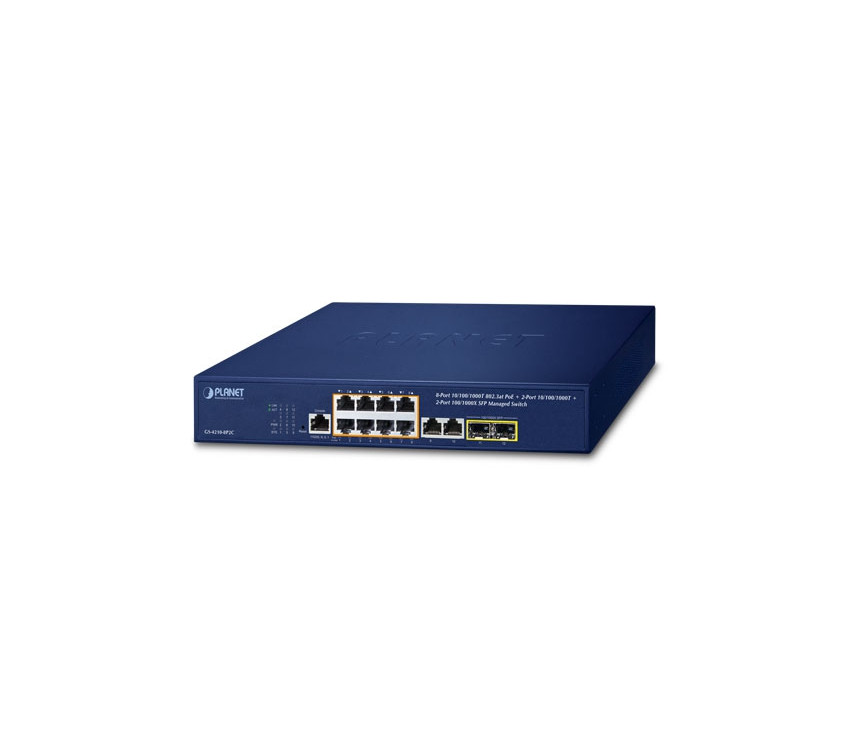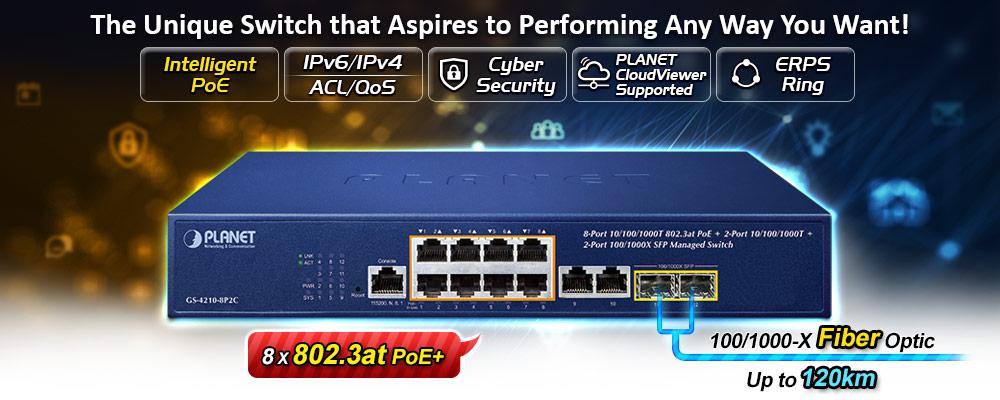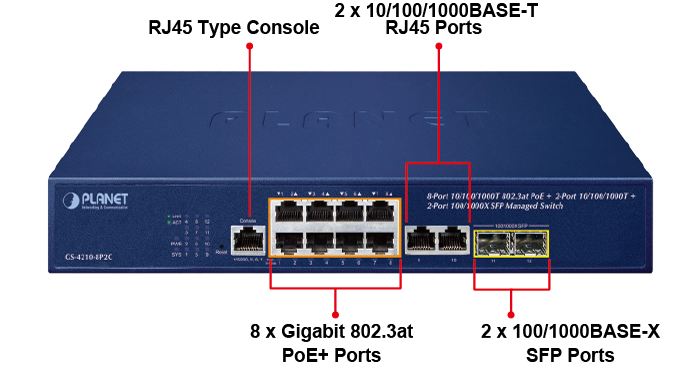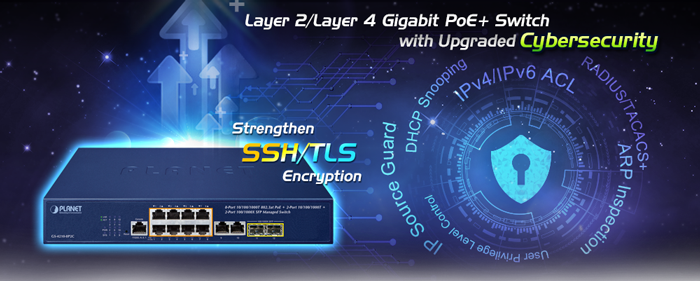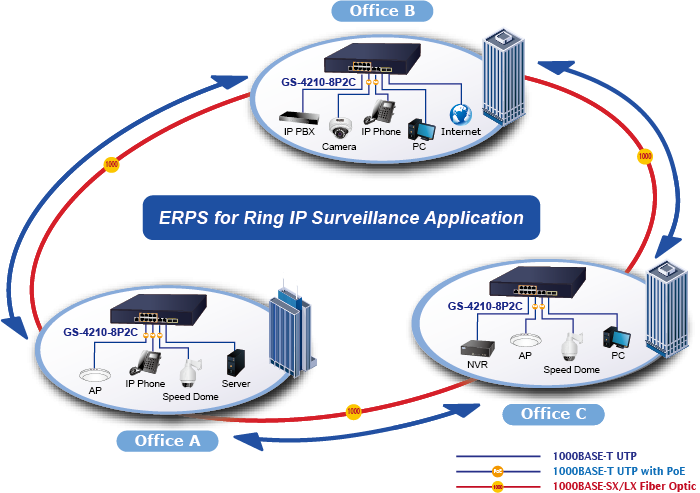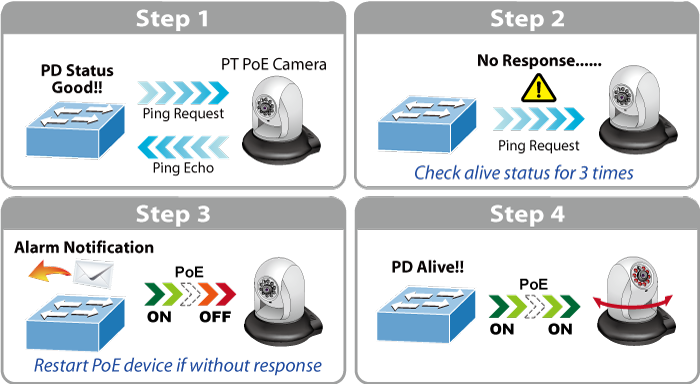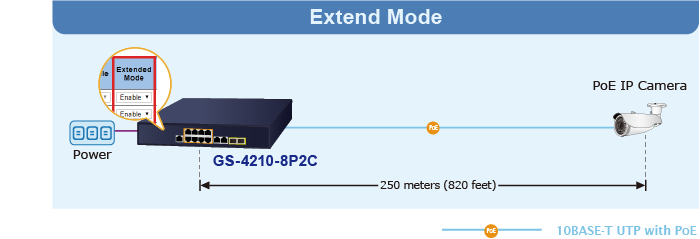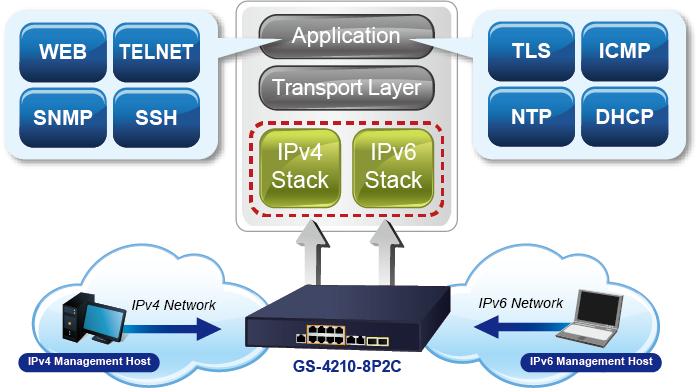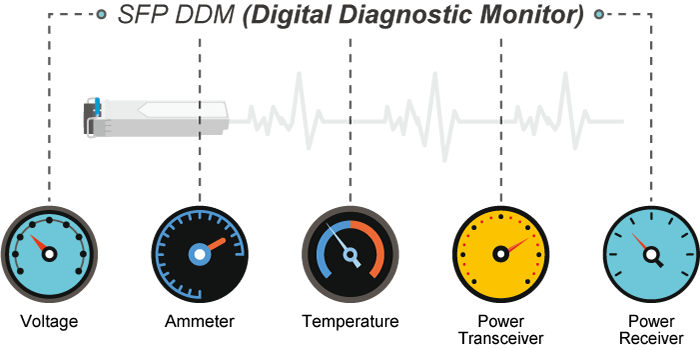Product added to cart
Planet 10-Port 802.3at PoE 2-Port SFP Managed Switch
MPN: GS-4210-8P2C
SKU: PLA-GS-4210-8P2C
UPC:
$264.00
Special Price : (Login for Your Price)
Availability
Usually Ships 10-14 Business Days
A Perfect Managed PoE+ Switch with Advanced L2/L4 Switching and Security
PLANET GS-4210-8P2C is a cost-optimized, desktop-size Managed Gigabit PoE+ Switch featuring PLANET intelligent PoE functions to improve the availability of critical business applications. It provides IPv6/IPv4 dual stack management and built-in L2/L4 Gigabit switching engine along with 8 10/100/1000BASE-T ports featuring 32-watt 802.3at PoE+, 2 additional Gigabit copper ports and 2 additional 100/1000BASE-X SFP fiber slots. With a total power budget of up to 120 watts for different kinds of PoE applications, it provides a quick, safe and cost-effective Power over Ethernet network solution for small businesses and enterprises.
Cybersecurity Network Solution to Minimize Security Risks
The GS-4210-8P2C supports SSHv2 and TLS protocols to provide strong protection against advanced threats. It includes a range of cybersecurity features such as DHCP Snooping, IP Source Guard, ARP Inspection Protection, 802.1x port-based network access control, RADIUS and TACACS+ user accounts management, SNMPv3 authentication, and so on to complement it as an all-security solution.
Redundant Ring, Fast Recovery for Critical Network Applications
The GS-4210-8P2C supports redundant ring technology and features strong, rapid self-recovery capability to prevent interruptions and external intrusions. It incorporates advanced ITU-T G.8032 ERPS (Ethernet Ring Protection Switching) technology, Spanning Tree Protocol (802.1s MSTP) into customer’s network to enhance system reliability and uptime in various environments.
Built-in Unique PoE Functions for Powered Devices Management
As it is the managed PoE switch for surveillance, wireless and VoIP networks, the GS-4210-8P2C features the following special PoE management functions:
- PD Alive Check
- Scheduled Power Recycling
- PoE Schedule
- PoE Usage Monitoring
- PoE Extension
Intelligent Powered Device Alive-Check
The GS-4210-8P2C can be configured to monitor connected PD (powered device) status in real time via ping action. Once the PD stops working and responding, the GS-4210-8P2C will resume the PoE port power and bring the PD back to work. It will greatly enhance the network reliability through the PoE port resetting the PD’s power source, thus reducing the administrator’s management burden.
Scheduled Power Recycling
The GS-4210-8P2C allows each of the connected PoE IP cameras or PoE wireless access points to reboot at a specified time each week. Therefore, it will reduce the chance of IP camera or AP crash resulting from buffer overflow.
PoE Schedule for Energy Savings
Under the trend of energy savings worldwide and contributing to environmental protection, the GS-4210-8P2C can effectively control the power supply besides its capability of giving high watts power. The “PoE schedule” function helps you to enable or disable PoE power feeding for each PoE port during specified time intervals and it is a powerful function to help SMBs or enterprises save power and money. It also increases security by powering off PDs that should not be in use during non-business hours.
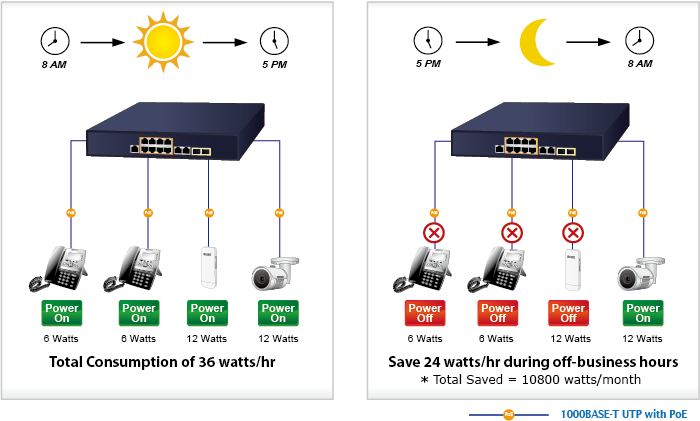
PoE Usage Monitoring
Via the power usage chart in the web management interface, the GS-4210-8P2C enables the administrator to monitor the status of the power usage of the connected PDs in real time. Thus, it greatly enhances the management efficiency of the facilities.
802.3at PoE+ Power and Ethernet Data Transmission Distance Extension
In the “Extend” operation mode, the GS-4210-8P2C operates on a per-port basis at 10Mbps duplex operation but can support 20-watt PoE power output over a distance of up to 250 meters overcoming the 100m limit on Ethernet UTP cable. With this brand-new feature, the GS-4210-8P2C provides an additional solution for 802.3at/af PoE distance extension, thus saving the cost of Ethernet cable installation.
Environmentally-friendly, Silent Fan Design for System Cooling
The GS-4210-8P2C features a desktop-sized metal housing, a low noise design and an effective ventilation system that help maintain the temperature of the PoE switch for optimal power output capability. Thus, the GS-4210-8P2C is able to operate reliably, stably and quietly in any environment without affecting its performance.
IPv6/IPv4 Dual Stack Management
Supporting both IPv6 and IPv4 protocols, the GS-4210-8P2C helps the SMBs to step in the IPv6 era with the lowest investment as its network facilities need not be replaced or overhauled if the IPv6 FTTx edge network is set up.
Robust Layer 2 Features
The GS-4210-8P2C can be programmed for advanced switch management functions such as dynamic port link aggregation, 802.1Q VLAN and Q-in-Q VLAN, Multiple Spanning Tree protocol (MSTP), loop and BPDU guard, IGMP snooping, and MLD snooping. Via the link aggregation, the GS-4210-8P2C allows the operation of a high-speed trunk to combine with multiple ports, and supports fail-over as well. Also, the Link Layer Discovery Protocol (LLDP) is the Layer 2 protocol included to help discover basic information about neighboring devices on the local broadcast domain.
Efficient Traffic Control
The GS-4210-8P2C is loaded with robust QoS features and powerful traffic management to enhance services to business-class data, voice, and video solutions. The functionality includes broadcast/multicast storm control, per port bandwidth control, IP DSCP QoS priority and remarking. It guarantees the best performance for VoIP and video stream transmission, and empowers the enterprises to take full advantage of the limited network resources.
Powerful Security
The GS-4210-8P2C offers comprehensive Layer 2 to Layer 4 Access Control List (ACL) for enforcing security to the edge. It can be used to restrict network access by denying packets based on source and destination IP address, TCP/UDP ports or defined typical network applications. Its protection mechanism also comprises 802.1x Port-based user authentication. With the private VLAN function, communication between edge ports can be prevented to ensure user privacy. The network administrators can now construct highly-secure corporate networks with considerably less time and effort than before.
Friendly and Secure Management
For efficient management, the GS-4210-8P2C is equipped with Command line, Web and SNMP management interfaces.
- With the built-in Web-based management interface, the GS-4210-8P2C offers an easy-to-use, platform-independent management and configuration facility.
- For text-based management, it can be accessed via Telnet and the console port.
- By supporting the standard SNMP protocol, the switch can be managed via any SNMP-based management software.
Moreover, the GS-4210-8P2C offers secure remote management by supporting SSHv2, TLSv1.2 and SNMPv3 connections which encrypt the packet content at each session.
Flexible Long-distance Extension Solution
The two mini-GBIC ports built in the GS-4210-8P2C support SFP auto-detection and dual speed as it features 100BASE-FX and 1000BASE-SX/LX SFP (small form-factor pluggable) fiber transceivers to uplink to backbone switch and monitoring center in long distance. The distance can be extended from 550 meters to 2 kilometers (multi-mode fiber) and to 10/20/40/60/80/120 kilometers (single-mode fiber or WDM fiber). They are well suited for applications within the enterprise data centers and distributions.
Intelligent SFP Diagnosis Mechanism
The GS-4210-8P2C supports SFP-DDM (Digital Diagnostic Monitor) function that can easily monitor real-time parameters of the SFP for network administrator, such as optical output power, optical input power, temperature, laser bias current, and transceiver supply voltage.
| MPN: | GS-4210-8P2C |
|---|---|
| Manufacturer | Planet Technology |
| Show Group Special Price | Yes |
| POE Compliant | 802.3 AT |
| Switch PoE Port | 8-Port |
| SFP Type | 1G SFP |
| Accessories |
|
| Hardware Specifications | |
|---|---|
| Copper Ports | 10 x 10/100/1000BASE-T RJ45 Auto-MDI/MDI-X ports |
| SFP Ports | 2 x 100/1000BASE-X SFP interfaces Supports 100/1000Mbps dual mode and DDM |
| PoE Injector Port | 8 ports with 802.3at/af PoE injector function with Port-1 to Port-8 |
| Console | 1 x RS-232-to-RJ45 serial port (115200, 8, N, 1) |
| Reset Button | < 5 sec: System reboot > 5 sec: Factory default |
| Dimensions (W x D x H) | 280 x 180 x 44 mm, 1U height |
| Weight | 1.7kg |
| Enclosure | Metal |
| Power Requirements | AC 100~240V, 50/60Hz, 4A, auto-sensing |
| Power Consumption/ Dissipation | 154 watts (max.)/525BTU |
| ESD Protection | Contact Discharge 6KV DC Air Discharge 8KV DC |
| Fan | 1 fixed speed Fan |
| LED | System: PWR (Green) SYS (Green) Per 10/100/1000T RJ45Ports Port (Port 1 to Port 10): LNK (Green), ACT (Blinks) Per PoE Port (Port 1 to Port 8): PoE-in-use (Amber) Per Gigabit SFP Port (Port 11 to Port 12): LNK (Green), ACT (Blinks) |
| Switching Specifications | |
| Switch Architecture | Store-and-Forward |
| Switch Fabric | 24Gbps/non-blocking |
| Switch Throughput@64Bytes | 17.85Mpps |
| Address Table | 8K entries |
| Shared Data Buffer | 4.1 megabits |
| Flow Control | IEEE 802.3x pause frame for full duplex Back pressure for half duplex |
| Jumbo Frame | 10K bytes |
| Power over Ethernet | |
| PoE Standard | IEEE 802.3af/802.3at PoE / PSE |
| PoE Power Supply Type | End-span |
| PoE Power Output | Per Port 54V DC, 32 watts (max.) |
| Power Pin Assignment | End-span: 1/2 (+), 3/6 (-) |
| PoE Power Budget | 120 watts (max.) |
| Number of 802.3af PDs | 7 units |
| Number of 802.3at PDs | 4 units |
| PoE Management | PD Alive Check Scheduled Power Recycling PoE Schedule PoE Usage Monitoring PoE Extension |
| Layer 2 Functions | |
| Port Mirroring | TX/RX/both Many-to-1 monitor Up to 4 sessions |
| VLAN | IEEE 802.1Q tagged-based VLAN IEEE 802.1ad Q-in-Q tunneling Voice VLAN Protocol VLAN Private VLAN (Protected port) GVRP Up to 256 VLAN groups, out of 4094 VLAN IDs |
| Link Aggregation | IEEE 802.3ad LACP/Static Trunk Supports 2 trunk groups with 4 ports per trunk |
| Spanning Tree Protocol | STP, IEEE 802.1D Spanning Tree Protocol RSTP, IEEE 802.1w Rapid Spanning Tree Protocol MSTP, IEEE 802.1s Multiple Spanning Tree Protocol STP BPDU Guard, BPDU Filtering and BPDU Forwarding |
| IGMP Snooping | IPv4 IGMP (v2/v3) Snooping IPv4 IGMP Querier Up to 256 multicast groups |
| MLD Snooping | IPv6 MLD (v1/v2) Snooping Up to 256 multicast groups |
| QoS | 8 mapping ID to 8 level priority queues Port number 802.1p priority 802.1Q VLAN tag DSCP field in IP packet Traffic classification based, strict priority and WRR |
| Ring | Supports ERPS, and complies with ITU-T G.8032 |
| Security Functions | |
| Access Control List | IPv4/IPv6 IP-based ACL MAC-based ACL |
| Security | IP-MAC port binding MAC filter Static MAC address DHCP Snooping and DHCP Option82 DoS attack prevention ARP inspection IP source guard |
| AAA | Built-in RADIUS client to co-operate with RADIUS server |
| Network Access Control | IEEE 802.1X – Port-based authentication RADIUS/TACACS+ user access authentication |
| Management Functions | |
| Basic Management Interfaces | RS232 Console Web browser Telnet SNMP v1, v2c |
| Secure Management Interfaces | SSHv2, TLS v1.2, SNMPv3 |
| System Management | Firmware upgrade by HTTP/TFTP protocol through Ethernet network LLDP protocol SNTP PLANET Smart Discovery Utility PLANET NMS System PLANET CloudViewer app |
| Event Management | Remote/Local Syslog System log |
| SNMP MIBs | RFC 1213 MIB-II RFC 1215 Generic Traps RFC 1493 Bridge MIB RFC 2674 Bridge MIB Extensions RFC 2737 Entity MIB (Version 2) RFC 2819 RMON (1, 2, 3, 9) RFC 2863 Interface Group MIB RFC 3635 Ethernet-like MIB RFC 3621 Power Ethernet MIB |
| Standards Conformance | |
| Regulatory Compliance | FCC Part 15 Class A, CE |
| Standards Compliance | IEEE 802.3 10BASE-T IEEE 802.3u 100BASE-TX/100BASE-FX IEEE 802.3z Gigabit SX/LX IEEE 802.3ab Gigabit 1000T IEEE 802.3x flow control and back pressure IEEE 802.3ad port trunk with LACP IEEE 802.1D Spanning Tree protocol IEEE 802.1w Rapid Spanning Tree protocol IEEE 802.1s Multiple Spanning Tree protocol IEEE 802.1p Class of Service IEEE 802.1Q VLAN tagging IEEE 802.1x Port Authentication Network Control IEEE 802.1ab LLDP IEEE 802.3af Power over Ethernet IEEE 802.3at Power over Ethernet Plus IEEE 802.3az Energy Efficient Ethernet RFC 768 UDP RFC 793 TFTP RFC 791 IP RFC 792 ICMP RFC 2068 HTTP RFC 1112 IGMP version 1 RFC 2236 IGMP version 2 RFC 3376 IGMP version 3 RFC 2710 MLD version 1 RFC 3810 MLD version 2 ITU G.8032 ERPS Ring |
| Environment | |
| Operating | Temperature: 0 ~ 50 degrees C Relative Humidity: 5 ~ 95% (non-condensing) |
| Storage | Temperature: -20 ~ 70 degrees C Relative Humidity: 5 ~ 95% (non-condensing) |
Physical Port
- 8-Port 10/100/1000BASE-T Gigabit RJ45 copper with 8-Port IEEE 802.3at/af PoE Injector function (Port-1 to Port-8)
- 2-Port 10/100/1000BASE-T Gigabit RJ45
- 2 100/1000BASE-X SFP ports
- RJ45 console interface for switch basic management and setup
Power over Ethernet
- Complies with IEEE 802.3at Power over Ethernet Plus, end-span PSE
- Backward compatible with IEEE 802.3af Power over Ethernet
- Up to 8 ports of IEEE 802.3af/802.3at devices powered
- Supports PoE power up to 32 watts for each PoE port
- Auto detects powered device (PD)
- Circuit protection prevents power interference between ports
- Remote power feeding up to 100 meters in standard mode and 250m in extend mode
- PoE management
- Per port PoE function enable/disable
- PoE port power feeding priority
- Per PoE port power allocation
- PD classification detection
- PD alive check
- PoE schedule
Layer 2 Features
- Prevents packet loss with back pressure (half-duplex) and IEEE 802.3x pause frame flow control (full-duplex)
- High performance Store and Forward architecture, broadcast storm control, runt/CRC filtering eliminates erroneous packets to optimize the network bandwidth
- Supports VLAN
- IEEE 802.1Q tagged VLAN
- Provider Bridging (VLAN Q-in-Q) support (IEEE 802.1ad)
- Protocol VLAN
- Voice VLAN
- Private VLAN (Protected port)
- Management VLAN
- GVRP
- Supports Spanning Tree Protocol
- STP (Spanning Tree Protocol)
- RSTP (Rapid Spanning Tree Protocol)
- MSTP (Multiple Spanning Tree Protocol)
- STP BPDU Guard, BPDU Filtering and BPDU Forwarding
- Supports Link Aggregation
- IEEE 802.3ad Link Aggregation Control Protocol (LACP)
- Cisco ether-channel (static trunk)
- Maximum 2 trunk groups, up to 4 ports per trunk group
- Provides port mirror (many-to-1)
- Loop protection to avoid broadcast loops
- Supports ERPS (Ethernet Ring Protection Switching)
Quality of Service
- Ingress/Egress Rate Limit per port bandwidth control
- Storm Control support
- Broadcast/Unknown-Unicast/Unknown-Multicast
- Traffic classification
- IEEE 802.1p CoS
- TOS/DSCP/IP Precedence of IPv4/IPv6 packets
- Strict priority and Weighted Round Robin (WRR) CoS policies
Multicast
- Supports IPv4 IGMP snooping v2 and v3
- Supports IPv6 MLD snooping v1, v2
- IGMP querier mode support
- IGMP snooping port filtering
- MLD snooping port filtering
Security
- Authentication
- IEEE 802.1X Port-based network access authentication
- Built-in RADIUS client to co-operate with the RADIUS servers
- RADIUS/TACACS+ login user access authentication
- Access Control List
- IPv4/IPv6 IP-based ACL/ACE
- MAC-based ACL/ACE
- MAC Security
- Static MAC
- MAC Filtering
- Port Security for Source MAC address entries filtering
- DHCP Snooping to filter distrusted DHCP messages
- Dynamic ARP Inspection discards ARP packets with invalid MAC address to IP address binding
- IP Source Guard prevents IP spoofing attacks
- DoS Attack Prevention
Management
- IPv4 and IPv6 dual stack management
- Switch Management Interface
- Web switch management
- Console/Telnet Command Line Interface
- SNMP v1 and v2c switch management
- SSHv2, TLSv1.2 and SNMPv3 secure access
- User Privilege Levels Control
- Built-in Trivial File Transfer Protocol (TFTP) client
- BOOTP and DHCP for IP address assignment
- System Maintenance
- Firmware upload/download via HTTP/TFTP
- Configuration upload/download via HTTP/TFTP
- Dual Images
- Hardware reset button for system reboot or reset to factory default
- SNTP Network Time Protocol
- Cable Diagnostics
- Link Layer Discovery Protocol (LLDP) Protocol and LLDP-MED
- SNMP trap for interface Link Up and Link Down notification
- Event message logging to remote Syslog server
- Four RMON groups (history, statistics, alarms, and events)
- PLANET Smart Discovery Utility for deployment management
- PLANET NMS system and CloudViewer for deployment management
Write Your Own Review



